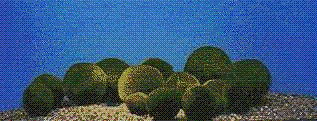

To answer this question we have collected and offer within these pages information about marimo from both scientific and historical perspectives including information on recent efforts to preserve and protect this unusual plant.
The emergence of the Marimo Festival as one of the largest events in Hokkaido represents society's renewed appreciation and respect for this precious velvety water plant. We invite you to examine this page and other marimo-related pages to discover more about this unique plant often referred to as the jewel of the lake.

 Why Do Marimo
Why Do Marimo
 History of The
History of The
Marimo's Plight
 The Marimo Exhibition
The Marimo Exhibition
and Observation Center
 A Message From Mr. Isamu Wakana of the Akan-cho Board of Education
A Message From Mr. Isamu Wakana of the Akan-cho Board of Education
Reporting The Most Recent Research Findings
Almost a century has passed since Tetsuya Kawakami of the Sapporo Agricultural School(now Hokkaido University) first discovered marimo in Lake Akan. Though Lake Akan is most noted for marimo, they also live in Lakes Shirarutoro and Toro near Kushiro's famous wetland area known as Kushiro Shitsugen National Park. Marimo also inhabit Lakes Kawaguchi and Sai, two of The Five Lakes of Mt. Fuji. Lake Akan, however, is the only lake which offers superb samples of velvety round marimo which occasionally reach diameters of between 20 and 30 centimeters. These beautiful, unique living creatures have been described as jewels of the lake. In 1921 marimo were designated as a Japanese Natural Treasure and, in 1952, they were further elevated in esteem through designation as a Special Japanese Natural Treasure.
Spherical marimo were first discovered in 1824 by physician and botanist Dr. Anton E. Sauter. His report on spherical marimo in Lake Zeller (Zeller See), Austria attracted the attention of many botanists. Marimo were subsequently found to exist in the United Kingdom, Russia, and Sweden as well as other countries.
The marimo's scientific name is Cladophora aegagropila and they belong to the Cladophora sauteri or Cladophora aegagropila family. Cladophora means branched plant. And, as he was the first to discover the marimo, sauteri is a derivative of Dr. Sauter's name.
Lake Akan has become the only lake in the world today where large round marimo can still be observed. We welcome your interest in marimo and through these pages invite you to discover how we humans have affected the marimo's way of life and how the marimo has, in turn, affected our lives.
Please contact the Regional Promotion Division of Akan-cho's Town Hall for additional information.
Edited by the Regional Promotion Division of Akan-cho's Town Hall.
Geographical note: Akan-cho refers to an area in southeast Hokkaido. While a lovely town named Akan exists in Hokkaido, Akan-cho refers to a district within Akan-gun (county). The Akan-cho district includes the towns of Akan and Akan-kohan as well as small villages such as Fubushinai and Teshibetsu.
Language note: Like the English word deer, many Japanese nouns include both the singular and plural form of the noun. This translation remains true to the Japanese usage. Readers are encouraged to further explore the marimo's world. We realize that further investigation into marimo may reveal contradictions to this page's use of the word marimo.